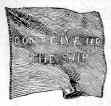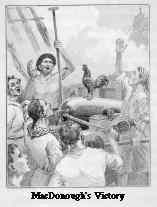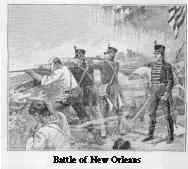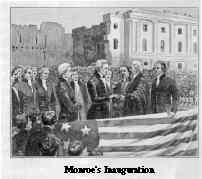Resource Center OLLibrary
|
204 |
|
[1812-1813 |
|
in the history of the world did an English frigate
haul down her colors to an American." But this was only
the beginning of our successes at sea, for out of fifteen
such battles we won twelve. Captain Hull brought his
prisoners to Boston. The Constitution, almost
unhurt, and henceforth known as Old
Ironsides,1 was hailed with ringing
cheers. Hull and his brave officers were feasted in
Faneuil Hall; Congress voted him a gold medal and gave
his men $50,000 in prize money. |
|
1814 ] |
|
205 |
That victory gave us control of Lake Erie,
and the British abandoned Detroit (§ 227).
230. Jackson's Victory at Tohopeka. The
next spring (1814) General Andrew Jackson, who was destined to be
President of the United States, marched against the Creeks, a
strong Indian tribe in the southwest territory, now forming the
states of Alabama and Mississippi. The Creeks had recently
massacred five hundred men, women, and children at Fort Mimms,
near Mobile. Jackson met the Indians in battle at Tohopeka, on a
branch of the Alabama River. (Map, p. 203.) He completely
destroyed their power, and they surrendered the greater part of
their territory to the United States.
231. Battles of Chippewa and Lundy's Lane;
Burning of Washington. In the summer of the same year (1814)
General Brown, with General Winfield Scott and General Ripley,
gained the battle of Chippewa, in Canada. Later, they drove the
British from a hard fought field at Lundy's Lane near Niagara
Falls. (Map, p. 203.)
Meanwhile, the British had blockaded all our
ports along the Atlantic coast, and had plundered and burned a
number of towns. Later in the summer (1814) they entered
Washington. (Map, p. 203.) President Madison fled in one
direction; Mrs. Madison, filling her workbag with silver spoons,
fled in another. The President's dinner, which had just been
served, was captured and eaten by the enemy. After dinner, Admiral
Cockburn, the English commander, and his officers, paid a visit to
the House of Representatives. Springing into the Speaker's chair,
he cried out, "Shall this harbor of Yankee democracy be burned?"
There was a general shout of "Aye!" "Aye!"
The torch was applied, and soon the evening sky
was red with the glare of the flames, which consumed the Capitol,
the President's house, and other public buildings. A recent
English historian1 says of that deed, "Few more
shameful acts are recorded in our history; and it was the more
shameful in that it was done under strict orders from the
government at home." 2
1 J. R. Green's
"History of the English People."
2 But we had burned (1813) the
Canadian government buildings at York (now Toronto), then the
capital of Canada. The truth is, that both sides perpetrated many
acts which time should make both forgive and forget.
|
206 |
|
[1814 |
|
232. Macdonough's Victory on Lake
Champlain; British Attack on Fort McHenry. A few
weeks after the burning of |
|
1815 ] |
|
207 |
|
had given up the attack, and were sailing down
Chesapeake Bay. Baltimore was safe, and soon every one
was joyously singing the new song, the "Star-Spangled
Banner." |
|
208 |
|
[1815- |
While the news of the treaty of peace was on
its way, delegates from most of the New England States met in
Hartford, Connecticut, in secret session. They were men who had
bitterly opposed the war from the beginning. It was reported that
the convention was plotting to dissolve the Union; but the
delegates declared that they met to secure defense for the New
England States, and to propose certain amendments to the
Constitution.
234. Results of the War. The war was
rightfully called our Second War of Independence." It had four
chief results:
1. The Revolution had made us independent on
land, the War of 1812 made us independent at sea. Henceforth Great
Britain respected our rights on the ocean and no longer tried to
"fence in the Atlantic."
2. The war showed foreign nations that any
attempt to establish themselves on the territory of the United
States (§ 233) was likely to end in disastrous failure.
3. By cutting off our foreign commerce for a
number of years the war caused us to build many cotton and woolen
mills (§ 205). This made us in far greater degree than before
a manufacturing people, -- able to clothe ourselves, instead of
having to depend on the looms of Great Britain for our "prints"
and our broadcloths.
4. Congress enacted a protective tariff, with
high duties (1816), to safeguard these mills and other American
industries against foreign competition (§ 266).
235. Summary. Madison's administration
was mainly taken up with the second war with Great Britain, which
began in 1812 and ended early in 1815. We declared war because
England refused to stop taking our sailors out of our ships and
forcing them into her service. The war put an end to this
practice. That was nearly a hundred years ago. Since then England
and America have always been at peace with each other. May that
peace never again be broken!
|
1817 ] |
|
209 |
|
236. Monroe's Administration
(Fifth President; Two Terms, 1817-1825); Monroe a Soldier
of the Revolution; his Inauguration.
Monroe,1 like Washington, got the best part of
his education on the battlefield. When |
 In
the autumn (1813), Commodore O. H. Perry gained a grand
victory on Lake Erie. Perry had built five vessels from
green timber cut on the shore of the lake. He added four
more vessels, and with that little fleet captured the
British fleet carrying more guns and more men. Before the
fight began he hoisted a flag over his vessel -- the
Lawrence -- bearing the words, "Don't give up the
ship."2 During the battle the Lawrence
was literally cut to pieces, and her decks covered with
dead and dying men. Perry saw that if he persisted in
staying where he was, he must be defeated. Taking his
little brother, a boy of twelve, with him, he jumped into
a boat, and ordered the crew to pull for the
Niagara. It was a perilous undertaking. The
British shot broke the oars to pieces, and young Perry's
cap was torn with bullets; but. the boat reached the
Niagara, and Perry gained the battle. Then, on the
back of an old letter, he wrote this dispatch to General
Harrison,
In
the autumn (1813), Commodore O. H. Perry gained a grand
victory on Lake Erie. Perry had built five vessels from
green timber cut on the shore of the lake. He added four
more vessels, and with that little fleet captured the
British fleet carrying more guns and more men. Before the
fight began he hoisted a flag over his vessel -- the
Lawrence -- bearing the words, "Don't give up the
ship."2 During the battle the Lawrence
was literally cut to pieces, and her decks covered with
dead and dying men. Perry saw that if he persisted in
staying where he was, he must be defeated. Taking his
little brother, a boy of twelve, with him, he jumped into
a boat, and ordered the crew to pull for the
Niagara. It was a perilous undertaking. The
British shot broke the oars to pieces, and young Perry's
cap was torn with bullets; but. the boat reached the
Niagara, and Perry gained the battle. Then, on the
back of an old letter, he wrote this dispatch to General
Harrison, Washington
a British expedition 14,000 strong moved down from Canada
by way of Lake Champlain to attack northern New York.
Commodore Macdonough had command of a small American
fleet on the lake. A British fleet carrying more guns and
more men attacked him (1814) in Plattsburg Bay. (Map, p.
203.) At the first broadside fired by the enemy, a young
gamecock kept as a pet on board Macdonough's ship, the
Saratoga, flew up upon a gun; flapping his wings,
he gave a crow of defiance that rang like the blast of a
trumpet. Swinging their hats, Macdonough's men cheered
the plucky bird again and again. He had foretold victory.
That was enough. They went into the fight with such
ardor, and managed their vessels with such skill, that in
less than three hours all of the British ships that had
not hauled down their flags were scudding to a place of
safety as rapidly as possible.
Washington
a British expedition 14,000 strong moved down from Canada
by way of Lake Champlain to attack northern New York.
Commodore Macdonough had command of a small American
fleet on the lake. A British fleet carrying more guns and
more men attacked him (1814) in Plattsburg Bay. (Map, p.
203.) At the first broadside fired by the enemy, a young
gamecock kept as a pet on board Macdonough's ship, the
Saratoga, flew up upon a gun; flapping his wings,
he gave a crow of defiance that rang like the blast of a
trumpet. Swinging their hats, Macdonough's men cheered
the plucky bird again and again. He had foretold victory.
That was enough. They went into the fight with such
ardor, and managed their vessels with such skill, that in
less than three hours all of the British ships that had
not hauled down their flags were scudding to a place of
safety as rapidly as possible. Early
the next year came the final battle of the war. The
contest had now lasted over two years. The British
determined to strike a tremendous blow at New Orleans. If
successful it might give them a foothold on the
Mississippi River. Sir Edward Pakenham with 10,000 picked
men made the attack (January 8, 1815). General Andrew
Jackson defended the approach to the city with
fortifications made of banks of earth and logs. He had
only half as many men as the British commander, and they
were men, too, who knew practically nothing about war,
but many of them were sharpshooters.
Early
the next year came the final battle of the war. The
contest had now lasted over two years. The British
determined to strike a tremendous blow at New Orleans. If
successful it might give them a foothold on the
Mississippi River. Sir Edward Pakenham with 10,000 picked
men made the attack (January 8, 1815). General Andrew
Jackson defended the approach to the city with
fortifications made of banks of earth and logs. He had
only half as many men as the British commander, and they
were men, too, who knew practically nothing about war,
but many of them were sharpshooters. the
Revolution broke out he was a student in the College of
William and Mary, Virginia. He threw down his books and
went to do his part in the cause of liberty. Among the
gallant officers who helped to gain the victory of
Trenton (§ 174) James Monroe, then only eighteen,
was one.
the
Revolution broke out he was a student in the College of
William and Mary, Virginia. He threw down his books and
went to do his part in the cause of liberty. Among the
gallant officers who helped to gain the victory of
Trenton (§ 174) James Monroe, then only eighteen,
was one.


